#aix-la-chapelle
Text

" P I N K " // © S҉ᕱცᏒᎥภᕱ
#Aix-la-Chapelle#France#Macro#Flower#Depth of Field#DOF#Tones#photography#aesthetics#wanderlust#explore#follow#discover
82 notes
·
View notes
Text

Aachen Cathedral at night as seen from Annastraße.
Photo by Christian Wehrle
#aachen#cathedral#aachen cathedral#aix-la-chapelle#churches#buildings#historic buildings#historical#rheinland#rhineland#nrw#nordrhein westfalen#west germany#germany#deutschland#deutsches tumblr#deutsche geschichte#nordeuropa#europe#european#europa#history#medieval architecture#urban landscape#cityscape#city scene#wikipedia#medieval aesthetic#medieval#religion
11 notes
·
View notes
Text




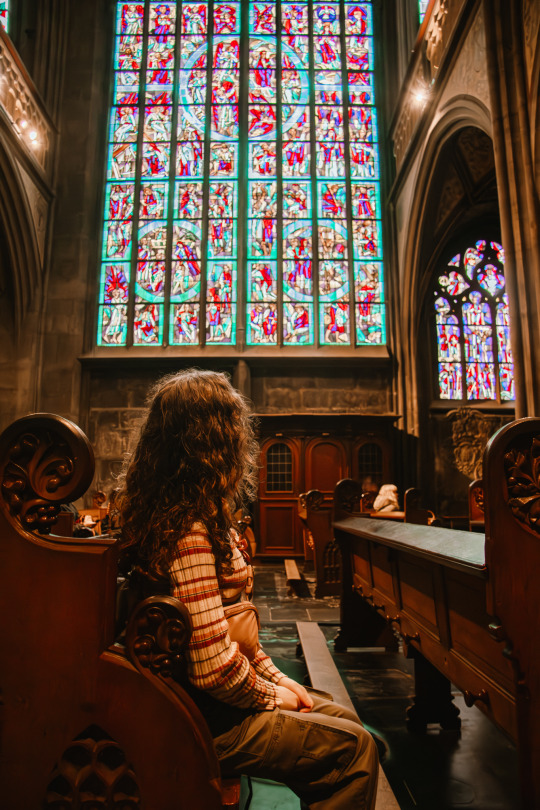

Aix-la-Chapelle Cathedral, Aachen, Germany
This chapel located in Aachen, Germany is the first cathedral our group of students visited to begin study abroad. I remember being struck by the vast expanse of the cathedral paired with the incredibly detailed artistry lining every inch of the interior.
I selected this cathedral because of the impact it left on me. I still vividly remember walking in for the first time. The sense of awe that I felt then, returns in memory.
The cathedral was commissioned by Charlemagne, the Holy Roman Emperor himself. There was no staple architecture style at this time so Charlemagne hired architects from Italy and other areas in Europe to collaborate on the Cathedrals design. The result became the origin of many European style churches to follow.
Because so many architects were called to work on this cathedral aspects of the architecture can be sorted into categories based on region. The Greek and Italian style marble collumns. The large mosaic dome and bronze doors bear the imprint of Byzantine tradition.
The stained glass was originally designed to portray Bible stories to the illiterate.
Aachen was Charlemagne’s favorite city. So much so that he was buried in this cathedral and his remains can still be found there today.
I was surprised by the magnitude of mosaics found in this cathedral. Every wall is covered upon entry and completely envelops the circumference of the chapel. I personally love mosaics and similar ceramic art. Knowing the time and planning that goes into completing a small mosaic, I was astounded by the time, effort, and attention to detail which was evident in the masterful artwork I saw on the walls.
7 notes
·
View notes
Text
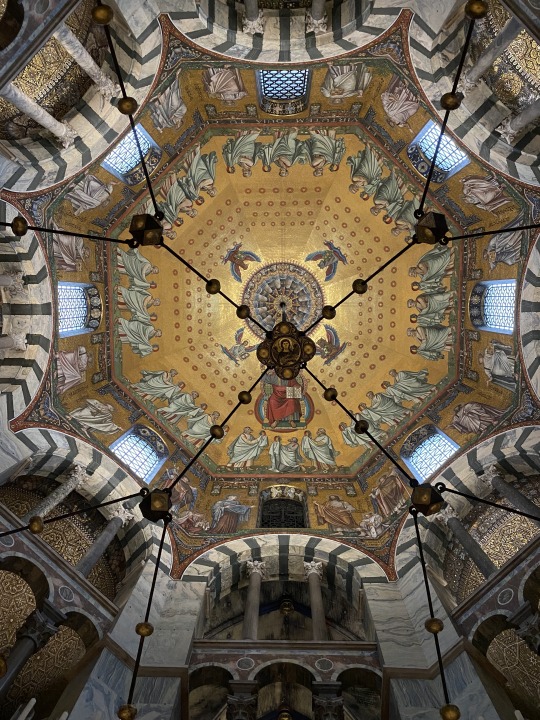
The Aachen Cathedral is one of the oldest and most prominent cathedrals in Europe. Charlemagne, emperor of the Holy Roman Empire, ordered its construction in the 800s as his chapel. The church's architectural magnificence is shown through both the Palatine Chapel and the Gothic choir, a late addition to the structure. The Palatine Chapel is an octagonal room with high ceilings and bronze accents throughout. The room is separated between a high section and a lower one, with Romanesque arches and groin vaults dominating the ceiling. The very top is painted with detailed images of the Apostles and different stories from scripture. The chapel served as the coronation spot for many kings and queens and was soon a place of pilgrimage after its canonization by the pope. The cathedral saw so many visitors that a beautiful Gothic choir was made in the 1300s, complete with pointed arches and large stained-glass windows, telling countless biblical stories. These biblical images in the church's design remained important for hundreds of years. The vast majority of people during these times were illiterate, and a primary source of biblical information, for them, was these works of art. This was even more important before the Reformation period because scripture was written and read in Latin under the catholic church in Europe. The most surprising thing to me about the Aix-la-Chapelle was that it was one of the first twelve Unesco world heritage sites and one of the most important churches in the world, and I had never heard of it until stepping foot in Aachen.
0 notes
Text

Aix-la-Chapelle
Aix-la-Chapelle est une des principales villes de Rhénanie-du-Nord-Westphalie, elle est idéalement située à proximité des frontières allemande, belge et néerlandaise, la rendant facile d'accès.
Principalement connue pour ses sources chaudes qui lui ont donné son statut de ville thermale et le tombeau de Charlemagne qu'elle héberge, c'est un bourg charmant avec de jolies façades gothiques, de nombreux restaurants traditionnels et d'agréables espaces verts.

Comment venir ?
Aix-la-Chapelle se situe :
en train : 20min de Liège, 30min de Cologne, 1h10 de Bruxelles, 2h40 de Paris
en voiture : 40min de Maastricht, 1h de Cologne, 1h de Bonn, 1h de Namur
en bus : 40min de Maastricht, 1h25 de Liège, 1h40 de Bonn, 2h40 de Bruxelles

Quand et combien de temps ?
Aix-la-Chapelle offre un cadre calme et plaisant pour un week-end détente ou une journée découverte. Nous étions venus en hiver, nous avons donc pu profiter du paysage enneigé mais la ville est aussi très agréable pendant les autres saisons.
Si vous restez plus longtemps vous pouvez prévoir des visites dans les nombreux musées de la ville, des activités thermales ou explorer les environs proches.

Que voir à Aix-la-Chapelle ?
Des monuments et sites historiques : Hôtel de ville, vieille ville historique, vestiges médiévaux, rue Pontstrasse, Elisabethhalle, quartier de Kornelimunster, rue Anatrasse, tour Granus, Rathaus, Ponttor, Marschiertor, fontaine aux moineaux (Möschebrunnen), Grashaus, Carolus Thermen, Casino, Pont Viértel, Katschhof, Elisenbrunnen, quartier du Pontviertel, Hof, Körbergasse, Burtscheid, quartier de Frankenberg, Kornelimünster, l'Eifel
Du patrimoine religieux : cathédrale, chapelle palatine
Des espaces naturels : le zoo Drimborner, Waldchen, forêt, l'Ehrenmal
Des musées : Centre Charlemagne, Musée Couven (vie de la bourgeoisie aux 18e-19e), IZM Musée international du journal (musée des médias), Musée Suermondt-Ludwig (art de l'Antiquité au modernisme classique), Büchel-Museum (musée privé dans une ancienne maison bourgeoise), NAK – La nouvelle fondation des arts (scène artistique locale), Trésor de l'abbaye de St Jean le Baptiste, Musée du CHIO (histoire du sport équestre), Ludwig Forum Aachen (art américain & européen depuis 1960)

Que voir dans les environs ?
Des villes et villages : Montjoie (Monschau), Maastricht, Liège, Cologne, Bruxelles
Des sentiers de randonnée : Inderoute, Dreiländerpunkt (tour d'observation), Rursee (lac de barrage), GR6, Genusstour 14, Feierabendrunde Aachen-Berensberg, Kupferroute, BR4, Eifelsteig, Wei��er Weg
Des pistes cyclables : Vennbahn (piste cyclable transfrontalière), route des châteaux entourés d'eau

crédits photos @lilstjarna
1 note
·
View note
Text



I have been sketching daily since the 27th June 2023 and thought I would try to keep the streak as long as possible. As a way to hold myself accountable I will post my daily sketches here. Enjoy the first sketches from the 27th June and a recent one from today. All of them done Plein Air urban sketches in Aachen, Germany
0 notes
Text
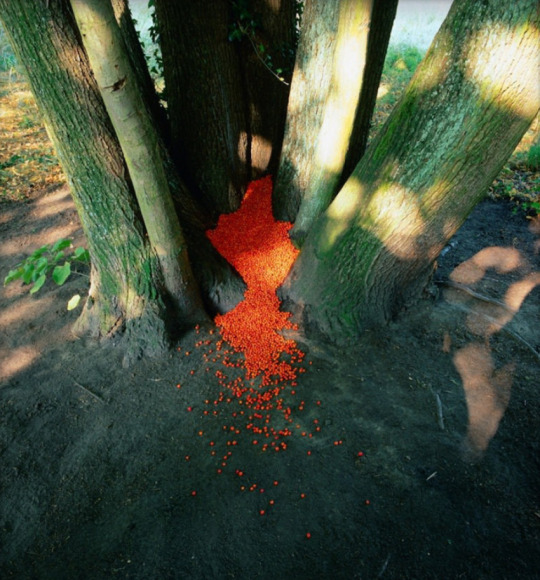

ANDY GOLDSWORTHY, Tilleul, sorbes, Aix-la-Chapelle, Allemagne, 1999
and Untitled, 1999
#arte#arte contemporanea#contemporary#contemporary art#art#digital media#photography#mine.cd#nature#andy goldsworthy#goldsworthy#mine.cd2
4K notes
·
View notes
Text


[New York, 1746 – First meeting ]
In 1744, King George's War was fought between the British, the British-American forces in the colonies and the Iroquois Confederacy against the French and the Wabanaki Confederacy of New France. Part of the Austrian War of Succession, it was fought mainly in New York and the Massachusetts bay. The battle meant tremendous losses for the colonies, with an estimated loss of 8% of the male population in Massachusetts. The Treaty of Aix-la-Chapelle ended the war in 1748, returning colonial borders back to how they were before the war. Three years later however, the town of Louisbourg was returned to France in exchange for the city of Madras (renamed to Chennai in 1996) in India. This city was captured by the French in September 1746 from the British, thus the "exchange". This angered New Englanders, who provided funding and personnel. The British paid Massachusetts £180,000 (roughly £32,281,486.29 in 2022), which the province then used to retire their currency.
[ Disclaimer : I am not, nor do I claim to be any expert on anything. I am constantly learning, so this post and others like it are subject to retcons and the like. Appropriate warnings will be given as I go. Also, please note that this, whilst based on history, is still a work of fiction. I do not condone nor support generally morally reprehensible things directly mentioned or alluded to on these. ]
1746 was more or less the midpoint of this war (with France launching a major expedition to recapture Louisbourg, the previous figures for Massachusetts losses being from 1745-46, etc.) and so the idea was for Susannah to act as the crown's (and by extension, Arthur's) eyes and ears to the colonies in direct response to the growing unrest. Alfred up until this point had been a loyal and steadfast son and subject, despite his eternal curiosity leading him to consume more and more literature that directly put old beliefs into question. Though he was not initially aware of Susannah's double allegiances, Alfred was aware of the formal, employer-employee arrangement between himself and Susannah. Despite that, his warm personality and similar wavelength of interests allowed him to easily breach the gap between 'acquaintance' and 'friend'. His father was often entire oceans away and this is the first time he met someone whom he could get attached to without fearing their mortality (see: humans Alfred had befriended throughout the years) or any perceived double national interests. The exchange of Louisbourg for Madras had been one of the many events that would plant the idea that his father was not entirely devoted to him in Alfred's mind. His conflicting feelings about the exchange and his place in the empire allowed him to open himself up to befriending Susannah, perhaps thinking that if he behaved well and treated who was essentially a bureaucratic extension of his Lord Father's presence well, perhaps he could earn his favor again.
Susannah on the other hand, was caught off guard by his lack of formality and had even found him to be somewhat "uncultured" in the beginning. The mainland British had mixed feelings about the colonists, but many of them held prejudices and saw them as "uncouth". As Suzie's household had mainly been attendants and tutors brought in from Britain, she shared their beliefs throughout her childhood. But slowly, as Suzie began to spend more time with Alfred, she warmed up to him, happy for the chance to finally be taken seriously instead of waved off for her more intellectual pursuits. Susannah was born in the colonies. But due to her ancestor, Sir Wilfred Knightley, whose affection and counsel she received growing up, her family has and continues to hold deep ties to the crown. Her beliefs and viewpoints were shaped simultaneously by her birthplace and her family's values. Though they were seen as upstarts in Britain, the Knightleys were an esteemed family in the colonies. She interacted with a lot of people from the mainland, a lot of important family friends and other acquaintances, but she'd also spent a lot of time talking to and mingling with colonists, both ranking ones and average, everyday people. To reflect the attitudes of many colonists, Susannah identified as a loyalist up until the middle of the Revolution.
[ commissions open | do not repost ] ocs by sunnysssol
#hetalia#aph america x oc#aph america#aph england#hetalia oc#hws assistantverse#oc: susannah knightley#oc: wilfred knightley#re: amesuzie [ canon timeline ]#[ 18th century ]#cc: alfred f jones#cc: arthur kirkland
93 notes
·
View notes
Text
Aix la Chapelle famous old Cafe "Fuzzy's"

12 notes
·
View notes
Text

Aix-la-Chapelle Cathedral (Aachen Cathedral)
The Aix-la-Chapelle Cathedral is located in Aachen, Germany. I chose this site because it was beautiful and our first trip this semester.
This specific Cathedral is connected to the European Reformation because Charlemagne, the first Holy Roman Emperor, ordered it to be built. Charlemagne was buried in this Cathedral, and then 31 kings and 12 queens were coronated in this Cathedral, where it remains the Mother Church of the Diocese of Aachen.
One thing that surprised me about Aix-la-Chappelle Cathedral was the Ancient Roman ruins that remain under the city, and how you can see some of them when you walk in the Cathedral.
5 notes
·
View notes
Text

On 11th December 1748 Charles Edward Stuart was arrested in Paris after failing to leave under the terms of the treaty of Aix-la-Chapelle.
Charlie had returned to France in 1746, he continued to be driven by his dynastic ambitions for a Stuart restoration in the years that followed he faced a series of setbacks and disappointments, the first was in 1647 when Pope Benedict XIV announced his intention to make Charles’s brother, Henry Benedict, a Cardinal – a Prince of the Catholic Church. Charles described this action as being like a dagger to his heart.
Think about the impact of this appointment: hopes of a Stuart restoration to the throne were now irrevocably dashed. Such an overt allegiance to the Catholic Church would make it difficult – if not impossible – for Charles to stake a claim. It became clear that King Louis would not finance another rising so Prince Charles, with his loyal servant, Archie Cameron, rode across the Pyrenees into Spain to try to win King Ferdinand to his cause, this again was unsuccessful.
Returning to France he was joined by his wife Jean, who had suffered badly during his absence, losing two of their children from exposure as they hid in caves and on the hills. The consolation was the king of France continued, however, to accord his visitor ‘moral support’, this was however about to change.
The dates differ slightly on this next setback, in December 1748 in accordance with the treaty of Aix-la-Chapelle, Charles was requested to leave France. Charles was told to leave forthwith for the Swiss city of Fribourg, a retreat Louis had arranged for him; but he refused to be dictated to and paraded around Paris as if he “owned the city and all of France.” He was warned that he would be arrested and bodily thrown out if necessary, but he still believed he could bluff out of existence in France.
One source tells us that things came to a head mid December when…….
“………Charles arrived by coach at the opera house. The footman who opened the doors was swiftly brushed aside by armed guards. Upon orders from his most Christian Majesty, the Prince was arrested, trussed hand and foot, and carried off to the person in Vincennes, where he was to remain until his senses were restored. On December 12th, Charles finely made his submission to the King of France by letter. After a grovelling preamble about his undying devotion to Louis’s sacred person, the Prince said he was ready to leave France as commanded. He was released with money and an escort and order to Avignon."
An objection was raised by the English government to his stay in this city, and Charles departed of his own accord, early 1749 he was given a residence by the Pope.
For the next few years his movements are wrapped in mystery, which recent investigation has only partially unveiled. For some time he was living secretly in Paris, though not unknown to the French government, with his mistress, Clementina Walkenshaw, who had joined him soon after his return from Scotland.
It is certain that he was in London in 1750, and that at this time he declared himself a protestant, under the idea that by so doing he would greatly improve his chance of obtaining the English crown.
There is also evidence he was in London in 1752 and 1754 to rouse the English Jacobites into action, but without success.
In 1766 James VIII and III died in Rome; his son would ‘inherit’ the right to become Charles III, but this required recognition from the Pope and Europe’s Catholic monarchs, to me this was the final nail in the coffin, this recognition was not forthcoming.
By the time of Prince Charles’s death in 1788 he had been reunited with his only daughter, Charlotte and she took care of her father in his final, ailing years.
18 notes
·
View notes
Text
“Everything Napoleon does and says is pleasant to me.”
— Letter from Josephine Bonaparte to her daughter Hortense, Aix-la-Chapelle, 4 August 1804
#source: château de malmaison#napoleon and josephine#Josephine#josephine bonaparte#napoleon bonaparte#hortense de beauharnais#hortense#napoleon#Napoleon’s family#couple#19th century#love#letter#letters#napoleonic#napoleonic era#romance#empress josephine#first french empire#French empire#France#history#ref#reference#source#1800s
28 notes
·
View notes
Text
Palace Whispers
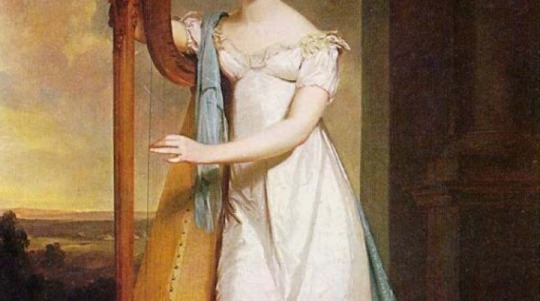
It was to be the greatest event of the 19th century - the coronation of Napoléon as Emperor of the French! Not in Aix-la-Chapelle or Reims, but in Paris, in Nôtre Dame! And His Holiness Pope Pius himself came to Paris to crown Napoléon!
Th imperial court had moved from Saint Cloud back to the Tuileries. Since my rank as a lady-in-waiting to the Empress was in the lower category as simple "Dame du Palais", I had far less importance than the "Dame d'honneur", the "Dame d'atour", or the "Dame d'accompagner". So the busy preparations for the coronation only affected me peripherally. But since everyone was so excited, the mood at court was more than brilliant! I enjoyed my service to the Empress, although I always -always! - entered her apartments with the trembling fear of meeting "him"! But the Emperor was so busy that he seldom came to see us. Once he appeared when I was playing the harp. The Empress never entered her salon until after eleven in the morning. Then she would chat with us about fashion or gossip. Some of the ladies were embroidering, someone was reading something, or I was playing the harp. When the Emperor came and I was playing a melody by Salieri, I jumped up and curtsied to the Emperor like all the ladies. But the Emperor did not notice us, so I allowed to continue plucking my harp. I only glanced at him once. My heart was pounding! It was magnificent to see how lovingly the imperial couple treated each other. Aunt Joséphine beamed at the Emperor so tenderly that one couldn't help but smile. But then my eyes fell on Madame de Vaudey and she looked at the Emperor not tenderly, but with pure desire! I saw a real greed for him in her eyes. It was almost indecent! The Emperor only gave her a brief glance. But her cheeks glowed with satisfaction! Élisabeth de Vaudey had everything I didn't have: she was tall, blonde, with big breasts that she juggled so skillfully in her cleavage as if they were about to sprang out at any moment. It was indeed fascinating to watch her, she loved to move her soft body with her slim waist and round bottom were more than provocative. But her voice sometimes sounded vulgar, too loud and exaggerated. Élisabeth had a self-confidence that I could only dream of. Her singing voice was really beautiful, but she never asked me to accompany her singing on the harp. She ignored me, never greeted me, never spoke to me. It seemed that she would never forgive me for the magical moment when I wore the Emperor's coat. The Empress herself was not at all jealous of the incident. "You looked so sweet, Adèle! All of Paris is talking about the Emperor's gallantry! Parisians love that kind of thing...and why not!" I remained a child to her, little Adèle, whom she had to protect.
One afternoon, however, the Emperor suddenly burst into the Empress's salon, beaming with joy! We were embroidering, nibbling on pastries and drinking a glass of Anisette. It was a somewhat boring afternoon, which was saved by the visit of the Emperor. We were still kneeling in our curtsy when I heard the Emperor say to Joséphine: "The Pope has arrived in Fontainebleau!" He took his wife's hand and kissed it passionately, with his eyes closed. Joséphine smiled happily. "Mesdames...the Pope is in Fontainebleau!" We applauded, and the Emperor finally looked at us. I quickly looked back at my embroidery. A minute or two passed...then the Emperor unexpectedly came to the small table where I was sitting with Félicité. He reached for my glass of Anisette, smelled it, took a sip, took another sip and then asked me: "Madame Duchâtel, do you know that Italian melody....mia dolce ragazza...avanti...facciamo l'amore...avanti...mia dolce ragazza...la...la...la..." He hummed the song loudly to himself. I looked up at him, uncertainly. "No, Your Majesty, unfortunately I do not know that melody." Then he looked at the Empress and said: "I can't get that damn melody out of my head!" Completely unexpectedly, Élisabeth then called out: "Sire, I know that melody...mia dolce ragazza..." she began to sing. The Emperor nodded, but turned around and slowly walked towards the door. I don't know what demon came over me at that moment, but I reached for my glass and put my lips exactly where the Emperor's mouth had touched the glass before! I closed my eyes blissfully for a second, then looked up at him. The Emperor was watching me. He smiled, knowingly!
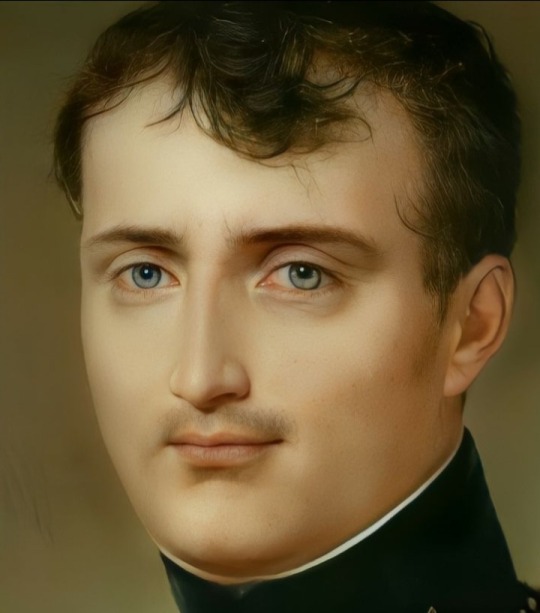
Only when he had gone did I take the glass from my lips, but kept it in my hand. Félicité had seen everything! She looked at me questioningly, but said nothing. Élisabeth had seen it too. When the Empress was distracted by Madame de Rémusat and Madame de Luçay, Élisabeth approached me. She leaned towards me and hissed like a cat: "Don't get any ideas...the Emperor is only interested in me!"
A few days later Églée came to me as I was tuning the harp in the Empress's salon. "Félicité told me about the incident with Élisabeth. You have to be careful, Adèle!" Églée sat down next to me. She continued in a quiet voice. "You won't find any friends among the ladies-in-waiting. Especially not if the Emperor or Empress favors you! You'll arouse envy and resentment...you don't want that, do you!" I shook my head violently. "No. Certainly not!" - "Good! You really have to be careful of Élisabeth, she's very scheming. Besides....she's a whore." I looked at Églée in surprise. "Just because she's sleeping with the Emperor?" That was my only conclusion. "No, but she's only doing it for money...not for love! Rapp told me something...you won't believe it!" I bit my lower lip expectantly. I already knew the most important thing for me - that Élisabeth didn't love the Emperor! I was infinitely relieved! And, of course, excited to hear what would happen next. Églée told me, not without pleasure: "Élisabeth wrote a letter to the Emperor...she was in financial difficulties...her creditors had given her a deadline. If she could not raise 30,000 Francs within twenty-four hours she would end up in debtors' prison. She would rather kill herself than go to debtors' prison! The Emperor was shocked! He sent Rapp to her with the money. But when Rapp entered her salon, he saw to his great surprise that Madame de Vaudey had not fallen into despair, but was sitting happily with several gentlemen at the gaming table, enjoying champagne! Rapp immediately turned back with the money and reported to the Emperor. Napoléon was furious!"
I had never heard such an exciting story! It sounded like something out of a novel. "Has the Emperor ended his affair with Élisabeth?" Églée shook her head. "I asked General Rapp that too, but he said that she might still have a chance with the Emperor...he's very fond of her!" Églée sighed. "Perhaps he loves her! Who knows? But one thing's for sure...Élisabeth will try everything to get the Emperor back! She's so raffinée...she knows these tricks that make men submissive." I looked questioningly at Églée. "Tricks...what do you mean?" I really had no idea what she meant by that. "Oh, you little sheep!" said Églée. "Don't you know that some women do things that men don't get from their wives? It's always been that way. A man's mistress must control him through her tricks in the art of love-making; only then can she keep him and his money! And as for Élisabeth, I can only hope that this affair will soon be over and that our dear Empress will not find out the least bit about it!"
But some time later a scandal broke out at the court of Empress Joséphine! The morning began like any other day, with tea and brioches and only two important topics to discuss: the coronation and our needle-work for Hortense's second son, the little Prince Napoléon Louis, who was only a few weeks old. I was working on a white bonnet with rabbits and ducks on a colorful meadow of flowers. I liked it very much, so I eagerly embroidered it. Églée sewed a tiny hussar jacket, for which Félicité sewed the trousers. We were all happily at work, when Élisabeth, who was practicing a melody on the harp, suddenly got up and left the salon. It might not have been noticed if she had not left this sudden silence behind her. Églée nudged me and whispered: "Something is going on..." I looked over, the Empress was discussing something with Madame de Rémusat. Aunt Joséphine seemed agitated. She kept whispering to Madame de Rémusat, who tried to calm her down. She finally succeeded and the Empress looked again at the book she had been reading. There was silence for a while. Suddenly the Empress jumped up, threw the book on the floor and said loudly: "That's enough! I can't stand it anymore!" She walked quickly to the door, elegantly lifting her train. Madame de Rémusat also jumped up and ran after her. "Your Majesty...please stay calm...I beg you!" She sounded desperate. All we saw was the rustling of the robes disappearing through the doorway. Silence remained. None of the ladies dared to say a word. Only Églée grinned. "I told you...this is the most exciting place in the world and I don't want to be anywhere else!" She continued sewing, still grinning. Old Madame de Chevreuse had fallen asleep, only Madame de La Rochefoucauld whispered eagerly with Madame de Soustras. These ladies came from the Ancien Regime, they came directly from the court of Marie Antoinette and were accordingly blasé. They wanted nothing to do with us young court ladies of the lower nobility or Bourgeoisie. Églée called them disparagingly "the old powder puffs!" The little gold clock on the mantelpiece tinkled, perhaps ten minutes had passed when suddenly the door was thrown open and the Empress entered. Her face was streaming with tears. She ran to her dressing room and immediately disappeared behind the door. At the same moment the Emperor appeared in our salon. His face was contorted with anger and of snow-white colour, his hair was disheveled. He had clenched his hands into fists and shouted: "You will not run away, Madame!" We could not so quickly sink into a curtsy as the Emperor strode across the room and disappeared into Joséphine's dressing room. And then we heard the Emperor shouting at his wife: "I'm fed up with your spying! You have no right whatsoever to interfere in my affairs! If I want to fuck my whores after breakfast, then that's not of your business! Do you hear me!!! I fuck whoever and whenever I want!" Then there was silence for a moment and we heard the Empress crying. Églée bit her lips with a grin and looked at Madame de La Rochefoucauld, who was holding a handkerchief to her open mouth. She seemed close to fainting. Then the door opened. "I want a divorce, Madame! Pack your things, you are leaving the Tuileries today!" Now we managed to curtsy in time. But the Emperor walked straight past us and disappeared. We looked at each other helplessly, neither of us said anything. From the Empress's dressing room we heard her loud crying. Madame de Rémusat finally went to her and closed the door. Madame de Chevreuse was still asleep.
We never saw Élisabeth de Vaudey again!
3 notes
·
View notes
Text
Retour à Ravenne
Une des rares choses que j'ai trouvées agréables pendant mon exercice de ''retrait de la vraie vie pour cause de désespoir profond'', c'est la possibilité de pouvoir rêver à des hypothèses qui ne font normalement pas partie de mes soucis quotidiens. Par exemple, je n'ai jamais le temps de me poser des questions comme : ''Le monde allant si mal, où ai-je envie de me réfugier, pour attendre la fin ?''... Sorti des poncifs incontournables (''les villes où je pourrais vivre, hors Paris, sont Rome et Athènes'' –auxquelles j'ajoute, moi, mon cher Rabat, unique objet de mes désirs secrets), on est très vite essoufflé. L'île Maurice, peut-être ? Et au delà ?
C'est lors d'une de ces ''rêveries d'un promeneur solitaire'' que m'est revenu, brutalement, un souvenir en forme d'éclair : Ravenne, à laquelle tant de moments d'extase m'attachent. On a beau avoir été prévenu par des parents ou des amis qui y ont été avant vous, l'électro-choc culturel, historique, esthétique et autres est assuré. En venant de Rome, il a d'abord fallu traverser ce désert humain et artistique qu'est la côte entre Ancona et Cesenatico : un étalage de toute la laideur, la vulgarité, la prétention, le néant dont est capable notre époque. Des foules immenses, heureuses de leur ''laisser-aller'', des hordes de caricatures déguisées en touristes, des tenues ''négligées'' par millions, des usines à malbouffe par centaines de milliers, des hôtels moches par dizaines de milliers, des SUV trop gros par milliers... tout est laid, vulgaire, raté... Au loin, le rocher de San Marino domine à pic ce paysage désolé, mais n'intéresse personne : il est trop loin du bruit et des ''boum-boum'' des sonos trop fortes...
On manque d'abandonner lorsque cela se transforme en marécages plus ou moins asséchés, assez désespérants, car on a l'impression qu'ils ne vont jamais finir... Et tout-à-coup, un panneau, à droite, inespéré : ''Ravenna, 3 km''. Zut : Il est trop tard pour découvrir la ville. Un autre panneau, en face ''Lido di Ravenna, 1 km''. Le temps de trouver un hôtel les pieds dans l'eau, de piquer une tête dans l'Adriatique et de louer ''una Vespa'' pour pouvoir se prendre pour Gregory Peck et Audrey Hepburn dans ''vacances romaines'' (l'obligation de porter des casques –rouges dans ce cas-- garantissant que le rêve ne durera que quelques secondes !), et on est prêt pour la visite.
Et c'est là que le ciel vous tombe sur la tête : tout est beau, tout est grandiose, tout est à dévorer des yeux... Cette petite ville portuaire du delta du Po, de nos jours endormie et un peu boudée par les hordes assoiffées de vide ensoleillé et de nuits passées à se trémousser en rythme, fut en d'autres temps la seule ''charnière'' entre l'Empire romain d'occident, en chute vertigineuse, et l'Empire byzantin, alors au faîte de sa gloire. Devenue Capitale à la place de Rome, elle a entretenu pendant près de trois siècles l'héritage gréco-latin, devenant un foyer de maintien et le creuset de ce qui sera l'Europe.
Dans un ballet étourdissant –dont les traces s'étalent devant vous à chaque tour de roue de votre ''Vespa''-- apparaissent et disparaissent des empereurs éphémères, des rois barbares (germains, burgondes, wisigoths, voire huns), des généralissimes félons et des nobles exarques, des archevêques simoniaques et des cardinaux sans points éponymes (mais empêtrés dans le débat mortel du ''filioquisme'' qui offrira, un peu plus tard, Constantinople à l'islam... et nous à un futur peu prometteur), des architectes de génie, des créateurs de merveilles et des bâtisseurs pleins d'une foi évidemment d'inspiration divine, qui vont donner naissance à un monde nouveau dont la beauté vous explose littéralement au visage, dans un mariage réussi entre Rome, Byzance, Athènes, Jérusalem et tout le ''mare nostrum', dont Charlemagne s'inspirera (entre 793 et 813) dans la construction de sa Chapelle Palatine à Aix --dans laquelle il voudra être enseveli. en 814.
Décrire les monuments dignes de visite est inutile : d'abord parce que nous sommes dans un Blog, pas dans un guide touristique, et ensuite parce que... ils le sont tous ! En revanche, j'ai envie, en me replongeant dans les souvenirs de ces heures bénies, de vous expliquer le besoin que ces rues créent de vous faire revivre des moments de cette antiquité finalement proche (ou : rendue plus proche, grâce à elle) : c'est un temps peu connu de notre histoire, les programmes officiels ayant quelque peu tourné le dos à l'Empire byzantin. Outre Ravenne, j'ai ressenti cette attirance pour revivre l'épopée de Byzance-Constantinople dans les déserts de Syrie ou de Jordanie, où je ne pouvais me décider à quitter telles ruines de cités qui avaient été immenses (des arènes avec 15 000 places, ça implique des vraies ''villes'', avec cent mille habitants et plus !). Il faudra la poussée furieuse de l'islam pour mettre le mot ''fin'' sur cette merveilleuse aventure.
En 1453, Constantinople assiégée par Mehmet II el-Fatih (= le Conquérant) et sentant le danger de cette terrible menace, à supplié Venise, alors immense puissance maritime, d'envoyer sa flotte de galères pour desserrer l'étau. Mais l'une était ''filioquiste'' et l'autre, pas et cette querelle sur une préposition adverbiale (''par'', pour l'un, ''et'' pour l'autre !) a entraîné la fin du grandiose Empire byzantin... et a coûté aux générations suivantes un demi-millénaire (pour le moment) de malheurs, de contraintes, d'épreuves, de guerres (et de terrorisme !) et, depuis peu, de drames indescriptibles liés à la violence inhérente à l'Islam. L'histoire n'étant parfois qu'un éternel recommencement, fasse le ciel qu'une redite du destin de Ravenne (par exemple autour des mots ''amalgame'', ou ''migrant'' en lieu et place du ''filioque'' d'alors) nous soit épargnée, à nous et à nos descendants !
H-Cl.
3 notes
·
View notes
Text


NILS UDO, Tilleul, sorbes, Aix-la-Chapelle, Allemagne, 1999
and Hêtre, sorbes, Langeland, Danemark, 1993
#arte#arte contemporanea#contemporary#contemporary art#art#digital media#photography#mine.cd#nils-udo#nils udo#mine.cd1#nature
428 notes
·
View notes
Text

Entrée du Restaurant La Cour du Louvre - Avignon
Le Petit Louvre se dresse actuellement sur l’emplacement d’une ancienne Commanderie des Templiers édifiée en 1 273.
Cet édifice est d’un grand intérêt pour l’histoire de l’architecture gothique en Provence ; d’une part parce qu’il présente une architecture déjà aboutie d’inspiration septentrionale, qui paraît novatrice et assez isolée dans une région où les témoins conservés d’architecture religieuse du XIIIe siècle sont assez rares, d’autre part parce que son édification entre 1 273 et 1 281 en fait le seul témoin important d’une architecture gothique à Avignon antérieure à l’arrivée des papes. Il est le premier édifice de style gothique en Provence, avec l’église de Saint-Jean-de-Malte à Aix.
L’ordre des Templiers était un ordre religieux de moines soldats qui s’était donné pour mission de protéger les pèlerins se rendant en Terre Sainte.
Les Templiers deviennent rapidement un ordre de premier plan, au point d’être les créanciers des rois de France.
En 1 307, Clément V premier pape venu en AVIGNON abolit l’ordre des Templiers sur demande de Philippe le Bel Roi de France, envieux de la puissance et de la richesse de l’ordre. Les biens de l’ordre sont alors dévolus à l’ordre de Malte. L’ordre de Malte est encore aujourd’hui connu pour ses missions caritatives dans le monde entier
On dit que la construction du Palais des Papes, initié en 1 340 par le Pape Benoît XII, a été financée en partie grâce aux richesses dont l’ordre des Templiers a été dépouillé.
Sous la Révolution française la Commanderie des Templiers sera détruite, la chapelle seule restera le témoin de l’époque des Templiers.
La chapelle devient alors bien national.
En 1 875, Anselme Mathieu, un Avignonnais, rachète le lieu pour y construire un hôtel. Il l’appellera l’hôtel du Louvre. Anselme Mathieu, était un homme très proche du courant littéraire provençal appelé le Félibrige. Il accueillera ses plus illustres représentants, Frédéric MISTRAL, Théodore AUBANEL et Joseph ROUMANILLE. Ceux-ci, feront de l’hôtel du Louvre leur cercle de réunion.
#avignon#original photographers#photography#photographe#photographers on tumblr#photo#france#villagedefrance#tourism#francephotography#tourisme#vaucluse
2 notes
·
View notes